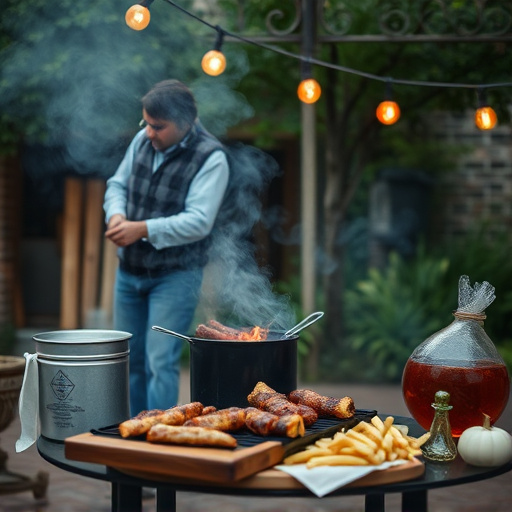Crafting homemade BBQ jerky is an accessible, cost-effective way for beginners to learn meat preservation while enjoying a healthy, customizable snack. Start with lean cuts of beef, pork, or chicken (5% fat or less). Use essential tools like a meat tenderizer and dehydrator. Marinate or dry-rub meat with spices for 12-24 hours before drying for 6-8 hours at 135°F. Store in airtight containers for up to several weeks in cool, dry conditions. Experiment with marinades, cuts, and slicing thicknesses for a personalized BBQ jerky recipe.
Looking to craft your first batch of homemade BBQ jerky? This step-by-step guide is tailored for beginners, offering a simple yet delicious recipe. From understanding the art of BBQ jerky and choosing the best meat, to mastering drying techniques and creative flavor variations, you’ll discover the secrets to making high-quality, long-lasting jerky. Elevate your grilling game with this easy BBQ jerky recipe and explore endless customization options!
- Understanding BBQ Jerky: Basics and Benefits
- Choosing the Right Meat for Homemade Jerky
- Essential Tools and Equipment Required
- Preparing the Meat: Marinade and Seasoning Ideas
- Drying Techniques for Perfect Texture
- Packaging and Storage Tips for Longevity
- Creative Variations to Personalize Your Jerky
Understanding BBQ Jerky: Basics and Benefits
BBQ jerky is a classic protein snack with a smoky, savory flavor that’s easy to make at home. It’s more than just a tasty treat; it offers several benefits for beginners looking to explore food preparation. Firstly, making your own BBQ jerky allows you to control the quality and ingredients, ensuring a healthier option free from preservatives and artificial flavors often found in store-bought varieties. This recipe is simple and customizable, letting you experiment with different spices and sauces to create unique flavors that cater to personal preferences.
Another advantage is cost-effectiveness. By preparing jerky at home, you can make a large batch for a fraction of the price of buying it pre-made. It’s an excellent way to introduce beginners to meat preservation techniques, offering a satisfying sense of accomplishment with every bite. Plus, homemade BBQ jerky makes a great on-the-go snack or addition to outdoor activities, providing sustained energy and protein without the added junk food.
Choosing the Right Meat for Homemade Jerky

When making homemade BBQ jerky, selecting the right meat is a crucial first step for beginners. Opting for lean cuts like sirloin or round steak ensures your jerky turns out tender and not overly greasy. These cuts of meat have less fat content, which is ideal as excess fat can make your jerky tough and difficult to chew. A good rule of thumb is to look for a meat with around 5% or less fat, ensuring it cooks evenly and stays juicy during the drying process.
For the ultimate BBQ jerky experience, consider using grass-fed beef as its natural fats contribute to a richer flavor profile. If beef isn’t your preference, lean pork cuts like tenderloin or even poultry such as chicken breast can also be excellent choices for beginners. Remember, the quality of your meat will greatly impact the final product, so choose wisely to satisfy your BBQ jerky recipe aspirations.
Essential Tools and Equipment Required

To make your first BBQ jerky batch a breeze, start by gathering some essential tools and equipment. You’ll need a good quality meat tenderizer to help break down the muscle fibers, ensuring your jerky turns out tender and flavorful. A sharp knife or butcher’s cleaver is crucial for slicing the meat evenly. For marinating and drying, a large container or zip-top bag will do the trick, along with some kitchen twine or butcher’s string. Don’t forget to invest in a food dehydrator – this appliance is key to creating perfectly crisp, chewy jerky. A thermometer is also handy to monitor the temperature during the drying process, ensuring your jerky reaches the safe minimum internal temperature. With these tools at hand, you’re well-prepared to tackle your first BBQ jerky recipe!
Preparing the Meat: Marinade and Seasoning Ideas
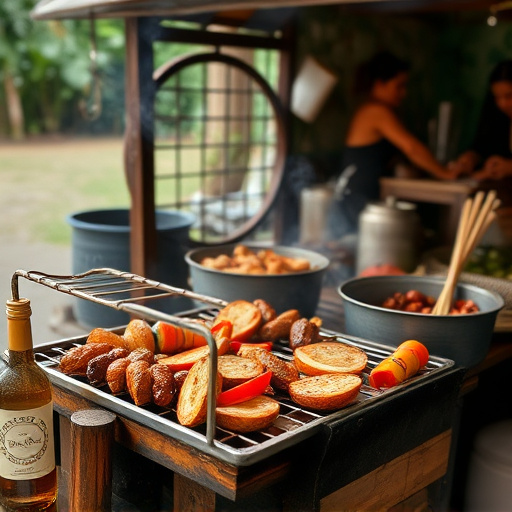
When preparing meat for a homemade BBQ jerky recipe, the first step is to select high-quality, lean cuts of meat. Beef or venison are popular choices due to their natural richness in protein and low fat content. Start with around 1-2 pounds (450g – 900g) of your chosen cut, such as sirloin or round steak. Ensure the meat is well marbled with fat, as this adds flavor during the drying process. Before seasoning, properly trim any visible fat and silver skin to avoid tough spots in your final jerky.
For delicious BBQ jerky, marinades and seasonings are key. A simple marinade can be made by combining olive oil, vinegar, salt, pepper, garlic powder, paprika, and a touch of brown sugar. Let the meat soak for 12-24 hours at room temperature to infuse the flavors. Alternatively, try a dry rub with spices like chili powder, cumin, oregano, cayenne pepper (for heat), and more salt and pepper. Massaging the seasoning into the meat before drying will ensure an even flavor distribution. Experiment with different blends to find your preferred taste profile for your BBQ jerky recipe.
Drying Techniques for Perfect Texture
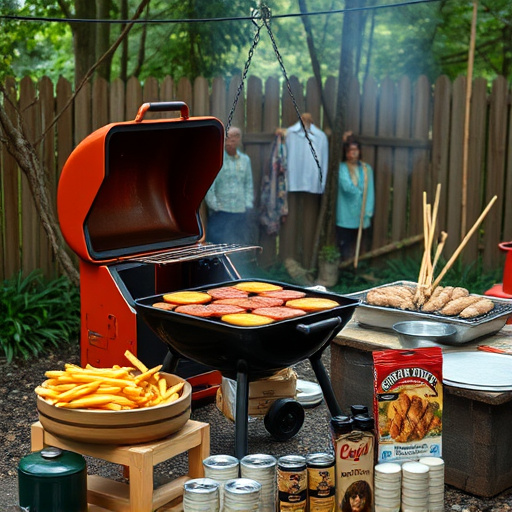
When it comes to achieving that perfectly tender and flavorful texture in your homemade BBQ jerky, the drying process is key. There are several techniques to choose from, each offering its own benefits for creating the ideal jerky experience. The traditional method involves using a dehydrator, which slowly removes moisture from the meat over an extended period, typically 6-8 hours or more. This ensures even dehydration, resulting in jerky that’s not only crisp but also lasts longer due to reduced moisture content.
An alternative and increasingly popular option is air drying. You can do this by hanging your seasoned meat strips in a cool, dry place with good air circulation, such as an attic or shed. The process takes several days to a week or more, depending on the temperature and humidity levels. While it requires more patience, air-drying yields jerky with a distinctively chewy texture that many prefer over dehydrator-made jerky. Experimenting with these different drying techniques allows you to tailor your BBQ jerky recipe to suit your personal taste preferences.
Packaging and Storage Tips for Longevity
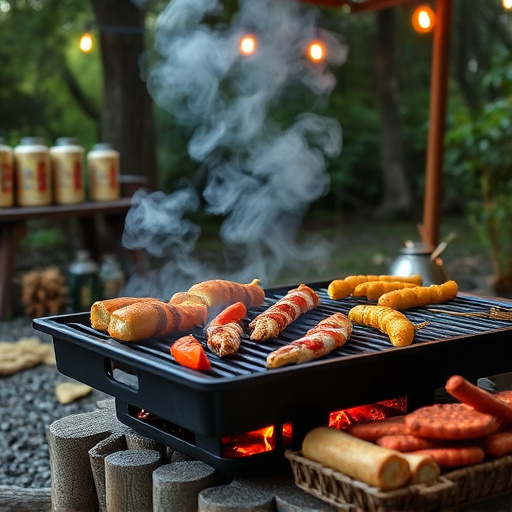
When it comes to storing your homemade BBQ jerky, remember that proper packaging is key to maintaining its freshness and longevity. Opt for airtight containers or sealable bags designed for food storage. This prevents exposure to air, moisture, and potential contaminants, all of which can accelerate spoilage. You can also consider using vacuum sealers for extra protection.
For long-term storage, it’s recommended to keep your jerky in a cool, dry place, such as a pantry or food safe fridge. Avoid direct sunlight and extreme temperatures. If stored correctly, BBQ jerky can last for several weeks. However, if you’ve used specific smoking and seasoning techniques, or added certain ingredients known to enhance preservation, your jerky could stay fresh even longer. Always remember to label your storage containers with the date of preparation for easy tracking.
Creative Variations to Personalize Your Jerky
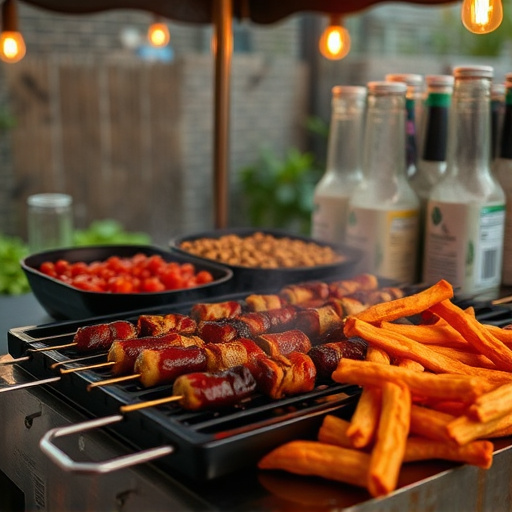
Adding a personal touch to your homemade BBQ jerky is an exciting way to make it even more delicious and unique. One simple variation is experimenting with different marinades; you can go beyond traditional BBQ sauces by infusing flavors like teriyaki, chipotle chili, or even a zesty lemon-herbs mix. These creative marinades not only enhance the taste but also add variety to your jerky experience.
For texture enthusiasts, trying out various cuts of meat can be intriguing. Instead of the usual beef, opt for chicken breast for a lighter option or go for venison for a gamey twist. You can also play around with cutting styles; thin slices create a crispier jerky, while thicker cuts result in a chewier texture. So, get creative and make your BBQ jerky recipe truly your own!
